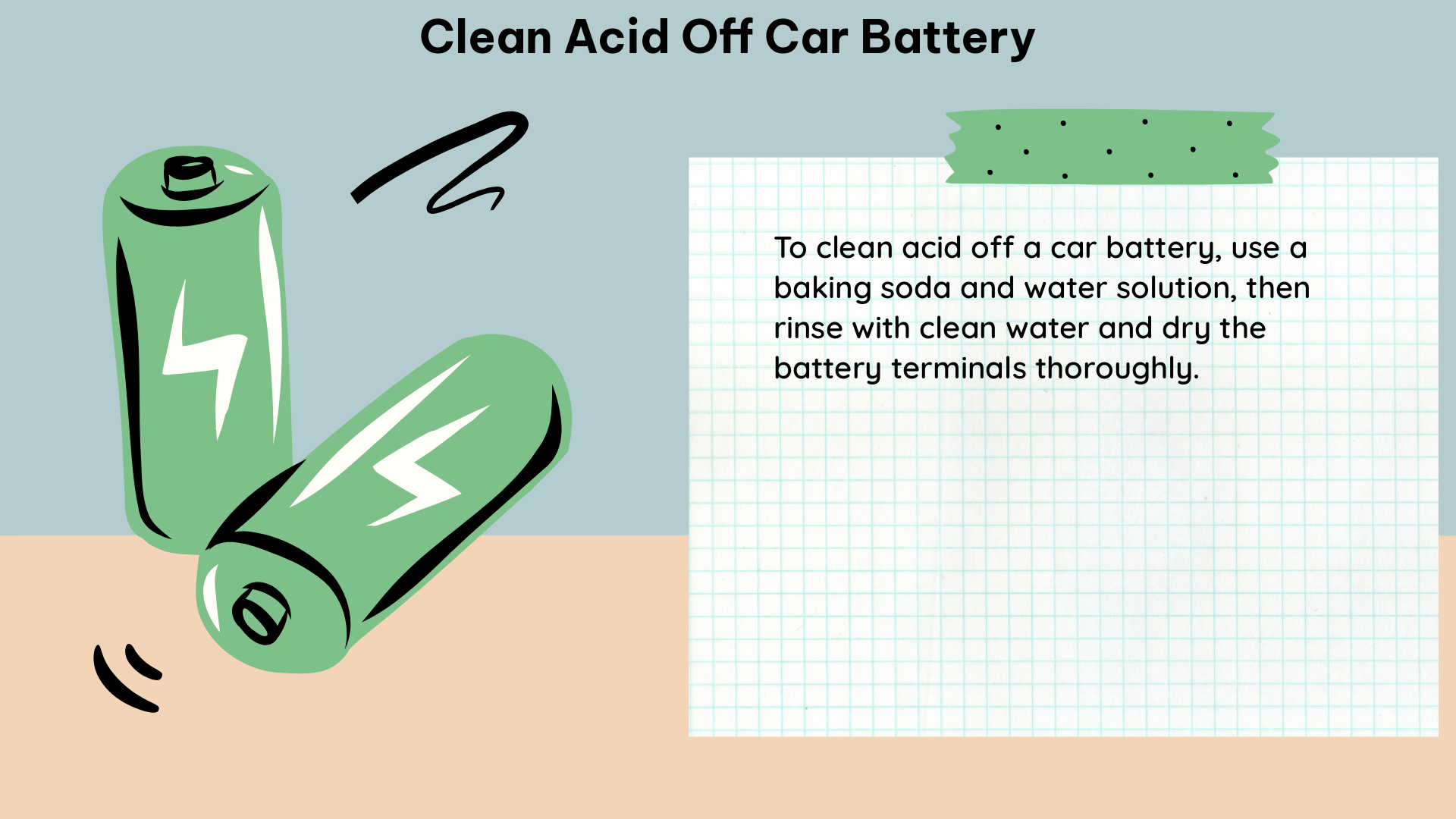Cleaning acid off a car battery is a crucial task to maintain the battery’s health and prevent further damage to the vehicle’s electrical system. This comprehensive guide will provide you with detailed, technical information on the best practices and methods to effectively clean acid off a car battery.
Understanding Battery Acid
Car batteries typically contain sulfuric acid, which is a highly corrosive substance. When this acid comes into contact with the battery terminals or other metal components, it can cause severe corrosion and damage. The acid can also create a hazardous environment if not properly contained and cleaned up.
The pH level of sulfuric acid in a car battery is typically around 1, which is highly acidic. This low pH level is necessary for the battery to function properly, as it allows the chemical reactions within the battery to occur. However, this acidity also makes the acid extremely dangerous to handle.
Preparing for Acid Cleanup

Before attempting to clean acid off a car battery, it is essential to take the necessary safety precautions. This includes:
- Wearing Protective Gear: Wear rubber or nitrile gloves, safety goggles, and a face shield to protect your skin and eyes from the corrosive acid.
- Ensuring Proper Ventilation: Work in a well-ventilated area, as the fumes from the acid can be harmful if inhaled.
- Gathering Cleanup Supplies: Assemble the necessary cleaning supplies, such as baking soda, water, a stiff-bristled brush, and absorbent materials like rags or paper towels.
Neutralizing the Acid
The most effective method for cleaning acid off a car battery is to use a baking soda and water solution. Baking soda is a base, which means it can neutralize the acidic properties of the sulfuric acid.
To create the neutralizing solution, mix 1 pound (454 grams) of baking soda per 1 gallon (3.8 liters) of water. This ratio ensures that the solution is strong enough to effectively neutralize the acid.
Once the solution is prepared, follow these steps:
- Carefully pour the baking soda and water solution over the affected areas of the battery, ensuring that the acid is fully covered.
- Allow the solution to sit for 5-10 minutes, giving it time to react with the acid and neutralize it.
- Use a stiff-bristled brush to gently scrub the battery terminals and any other areas with visible corrosion.
- Rinse the area with clean water to remove any remaining baking soda and acid residue.
Disposing of Hazardous Waste
After cleaning the battery, it is crucial to properly dispose of the hazardous waste. The neutralized acid solution and any contaminated materials, such as rags or paper towels, should be disposed of in accordance with local hazardous waste regulations.
Contact your local waste management authority or a hazardous waste disposal service to ensure the safe and proper disposal of the acid-contaminated materials.
Preventing Future Acid Spills and Corrosion
To prevent future acid spills and corrosion, it is essential to take the following precautions:
- Store Batteries Properly: Keep car batteries in a dry, cool location, away from direct sunlight and heat sources. This will help to minimize the risk of leaks and corrosion.
- Handle Batteries with Care: Avoid dropping or puncturing the battery, as this can cause the casing to crack and lead to acid leaks.
- Secure Battery Terminals: Ensure that the battery terminals are tightly secured to prevent short circuits, which can also cause acid to leak.
- Regularly Inspect and Maintain: Periodically inspect the battery and its terminals for signs of corrosion or damage. Clean the terminals as needed using a wire brush or a commercially available battery terminal cleaner.
- Apply Protective Coatings: Consider applying dielectric grease or a battery terminal protector to the cleaned terminals to prevent future corrosion.
By following these best practices, you can effectively clean acid off a car battery and maintain its long-term health and performance.
References:
- Cleaning Up a Battery Acid Spill
- How to Clean Battery Corrosion and What Causes It
- Cola vs. Baking Soda vs. Water to Clean Battery and What Should Be Used Afterward

The lambdageeks.com Core SME Team is a group of experienced subject matter experts from diverse scientific and technical fields including Physics, Chemistry, Technology,Electronics & Electrical Engineering, Automotive, Mechanical Engineering. Our team collaborates to create high-quality, well-researched articles on a wide range of science and technology topics for the lambdageeks.com website.
All Our Senior SME are having more than 7 Years of experience in the respective fields . They are either Working Industry Professionals or assocaited With different Universities. Refer Our Authors Page to get to know About our Core SMEs.